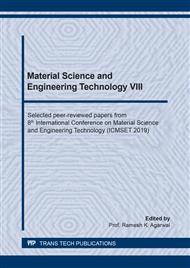p.209
p.215
p.221
p.227
p.233
p.239
p.246
p.255
p.261
Carboxylate-Functionalized Imidazolium-Based Binary Ionic Liquids as Electrolytes for Symmetric Carbon-Based Supercapacitors
Abstract:
Ionic liquids (ILs) containing 1-ethyl-3-methylimidazolium (EMIM) cations and carboxylate anions were prepared using solventless sonochemical synthesis followed by a facile halide-to-anion exchange method and were characterized for their structural and electrochemical properties. The structures of the synthesized ILs were found to significantly affect their electrochemical window (EW) and varied anions exhibited different reductive and oxidative limits. Ionic conductivity and cyclic voltammetry measurements revealed that [EMIM] hexanoate and [EMIM]2[oxalate] offered relatively high ionic conductivity values and wide EWs. A 1:1 binary IL mixture based on the synthesized ILs was prepared and its EW was found to significantly vary as compared with the EWs of the individual component ILs. Supercapacitor prototypes were then fabricated with edge-oxidized graphene sheets as conductive additives for the electrodes and electrospun nanofibers as separator membranes. An electric-double layer capacitive behaviour associated to the ion diffusion process of the electrolyte ions onto the porous electrode surface was shown and quasi-rectangular curves were observed having no redox peaks at any point in the generated repetitive voltammograms. These considerable results have shown valuable insights for further development of binary IL electrolytes for energy storage devices.
Info:
Periodical:
Pages:
233-238
Citation:
Online since:
June 2020
Authors:
Keywords:
Price:
Сopyright:
© 2020 Trans Tech Publications Ltd. All Rights Reserved
Share:
Citation:


